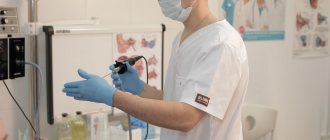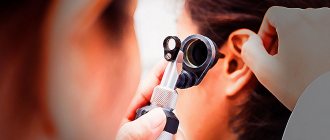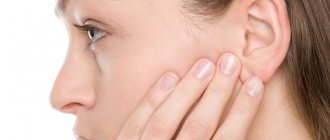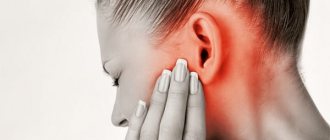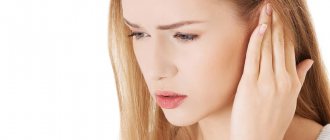Fungal external otitis is successfully treated in ENT clinic No. 1
Author:
- Golonova Yulia Yurievna
otorhinolaryngologist, clinic director
3.75 (Votes: 4)
The problem of fungal infection of the external auditory canal (otomycosis) is growing every decade. This is due to the problem of decreased immunity, frequent and uncontrolled use of antibiotic therapy, and the dietary habits of modern humans, who consume large quantities of food rich in carbohydrates, often leading to type 2 diabetes mellitus and increased blood glucose levels. All these reasons lead to an increased risk of developing fungal infections, including in the ear canal.
If we add to the overall picture the bad habit of “cleaning” or “scratching” the ears with all available objects, naturally non-sterile (including the so-called “ear” sticks, which are also non-sterile), which helps remove the natural protective factor from the ear canal - earwax and contaminated with all conceivable and inconceivable bacterial and fungal microflora - we get ideal soil for the formation of otomycosis.
Causes and course of the disease
Otomycosis is caused by yeast-like fungi of the genus Candida, as well as molds Aspergillus, Penicillium, and Rhizopus. The main factors that contribute to the occurrence and development of this disease are:
- Chronic otitis media, as well as diseases of the external auditory canal such as eczema and dermatitis;
- Skin microtraumas;
- Long-term use of hormones or antibiotics;
- Metabolic disorders and allergies;
- Special working conditions - work in a wardrobe, at a collection point for old things, or as a procurer of waste materials.
Another factor that contributes to the development of fungal pathology can be considered the structural features of the external auditory canal. In this case, the mushroom is protected from direct sunlight, which is detrimental to it. High humidity and optimal temperature, the absence of mechanical damage to the mycelium allow the fungus to multiply intensively. As a result, they form dense plexuses of mycelium, and this causes inflammation of the skin.
If mold otomycosis is caused by fungi of the genus Penicillium, then a serous discharge is observed in the external auditory canal, which is odorless and has a liquid consistency. Throughout the entire external auditory canal, soft crusts are observed, which have a yellowish-whitish color with black heads and are quite easily removed. Their greatest accumulation is detected on the eardrum and in the bony part of the auditory canal cavity.
The clinical picture of otocomycosis caused by yeast-like fungi of the genus Candida is very similar to weeping eczema of the outer ear. In this case, the pathological discharge may take the form of whitish-yellowish crusts or caseous masses of a whitish color and soft consistency that close the lumen of the ear canal. In the case of the development of candiomycosis, the process often involves the area behind the ear and the auricle.
Friends! Timely and correct treatment will ensure you a speedy recovery!
Disease prevention
In the prevention of otomycosis, strengthening the immune system, proper care of the ear canal and a balanced diet play an important role. Uncontrolled use of hormonal drugs and antibiotics is prohibited; it is also important to promptly and efficiently treat inflammatory diseases of the ENT organs. In case of recurrent ear diseases, it is necessary to protect the ear canal from water entering when bathing.
When the first symptoms of fungal inflammation of the ears appear, make an appointment with a medical otolaryngologist. Our clinics are equipped with modern equipment to conduct high-quality diagnostics of the condition of the ENT organs. An appointment with an ENT doctor can be made by calling 8(812) 322-93-91, or via the Internet by leaving a request on the website.
Clinical picture
Among the main symptoms of otomycosis are: itching in the ear, as well as its congestion and noise, increased sensitivity of the auricle and ear canal. Outside the period of exacerbation, pain in the ear, as well as in the head on the affected side, is mild. When performing otomicroscopy, a narrowing of the external auditory canal is observed due to skin infiltration. The walls of the ear canal are somewhat hyperemic (reddened). The pathological discharge is very similar to wet blotting paper, and its color depends on the color of the mycelium. If the infection was caused by the fungi Aspergillus niger, the discharge will be black-brown, and if the infection involved the fungi Aspergillus flavus, Aspergllus graneus, then it will be greenish or yellowish.
What should you be afraid of with otomycosis?
Fungal external otitis tends to chronicize the process, forming a sluggish, constantly persistent process of fungal inflammation. In this case, an increase in symptoms is provoked either by antibiotic therapy or changes in diet: an abundance of “fast” sugars - when the mushrooms begin to grow “by leaps and bounds.”
A long-term fungal process leads to sensitization (allergization) of the body, decreased immunity, and the presence of itching often leads to scratching and the risk of secondary purulent infection.
Treatment
First, you need to clean the ear canal with a warm solution of boric acid or potassium permanganate. After this procedure, you can use antifungal drugs, which are selected depending on the type of fungus. Fungal masses are afraid of ultrasonic vibrations and laser exposure, so these methods of physiotherapeutic treatment must be connected to the main treatment.
What to do if you suspect fungal otitis media?
First of all, immediately contact a specialized ENT clinic or ENT office. In Moscow, for example, at ENT clinic number 1, where an otorhinolaryngologist will conduct an endoscopic examination of the ear, to clarify the diagnosis, take discharge from the ear (smear) for fungi and prescribe complex therapy for this disease, which includes local therapy, general therapy and physical therapy.
One of the important elements of treatment is washing the ear canal with a medicinal solution in order to remove fungal mycelium and inflammatory discharge, after which ointment or drops that have a therapeutic effect are introduced onto the turunda, it is necessary for the medicine to act on the cleaned ear canal.
Red laser laser therapy is very effective for antifungal, anti-inflammatory and immune-modeling effects. The course of such treatment is 8-10 procedures.
After a course of complex therapy, it is recommended to give up the bad habit of “cleaning” your ears in order to allow earwax to protect you from such diseases in the future.
Major complications
In the absence of timely treatment, serious consequences develop:
- hearing loss (develops against the background of chronic otomycosis);
- extensive damage to the ear canal, eardrum, and tissues that surround the ears;
- the formation of adhesions that impede the normal perception of sound.
Also, fungus in the ears is dangerous for the development of complicated forms of otitis media or labyrinthitis. These conditions require urgent hospitalization of the patient.
Main types of fungus
The types of ear fungus are presented in the table:
| Classification by localization | Classification by duration | Classification by shape |
| Postoperative otitis media; otitis externa (external ear); otitis media, myringitis (inflammatory process affecting the eardrum). | Acute (manifests within 4-5 weeks); subacute (1-6 months), chronic (from six months). | Blastomycosis; Candidiasis; cryptococcosis; aspergillosis; coccidioidosis; mucodiosis. |
The inner ear is affected in 5-7% of cases.
If a pathogenic bacterium joins the “fungal” pests, mixed otomycosis is diagnosed.
Features of non-drug treatment
How to cure fungus in adults? First, the doctor must remove fungal plaque from the ears. The procedure is performed only in the clinic. It involves the use of an attic probe, as well as a quilted pad, which is moistened in an antimycotic solution.
Washing features:
- external mycotic otitis – the anterior inferior part of the auditory canal is cleaned;
- mycotic otitis media - washing the eardrum with antiseptics with antifungal effects (quinoline alcohol (0.1%) and miramistin solution are used).
Drug therapy
How to treat fungus? Features of drug therapy depend on the type of pathology:
- otitis externa Local medications are prescribed;
- candidal external otitis. A combination of 1% clotrimazole solution and 1% naftifine solution is recommended. Applications are prescribed, the duration of which varies from 5 to 10 minutes. Duration of therapy – 1-2 weeks, 2 times/24 hours;
- candidomycosis. The use of oxiconazole, econazole, natamycin, miconazole, bifonazole is recommended;
- external otitis caused by mold fungi. A solution of naphthyzine and chloronitrophenol is used;
- yeast infection. The use of fluconazole for fungus is recommended.
Fluconazole should not be used to treat mold mycosis.
Treatment regimen
Information on how to properly use medications for fungus in a person’s ears is presented in the table:
| Localization | Yeast-like fungi | Molds |
| Outer ear | Naftifine 1% solution + clotrimazole 1% solution (topically). | Naftifine 1% solution + chloronitrophenol 1% solution (topically). |
| Postoperative cavity | Naftifine 1% solution + clotrimazole 1% solution (topically), Fluconazole, capsules (orally). | Naftifine 1% solution + chloronitrophenol 1% solution (topically), Itraconazole, capsules or terbinafine, tablets (orally). |
| Middle ear | Naftifine 1% solution + clotrimazole 1% solution (topically), Fluconazole, capsules (orally). | Naftifine 1% solution + chloronitrophenol 1% solution (topically), Itraconazole, capsules (orally). |
Ointments, creams and drops
The best topical remedies for ear fungus are:
| Means | Description | How much does it cost (RUB) |
| Exoderil | This is an ointment for ear fungus. Effect: fungicidal, fungistatic, antifungal. | From 210 |
| Nitrofungin | Effective against fungi Trichophyton gypseum and Microsporum canis, Candida albicans. | 276 |
| Iodinol | Which drops help best? It is recommended to use Iodinol. The main effect is antiseptic. | From 230 |
| Candibiotic | Drops in the ears. Effects - antibacterial, antifungal, anti-inflammatory, analgesic. | 300-500 |
| Travocort | Anti-inflammatory, analgesic, antifungal. | 750-950 |
| Pimafukort | This is a cream for fungus. The main effect is anti-inflammatory. Helps cope with yeast-like fungi. | 510-610 |
We recommend reading: How to remove fungus from the body using folk remedies
How to treat children
A fungus in a child’s ear is treated in the same way as in an adult: cleaning out the pathological contents and using medication.
Typically, children are diagnosed with ear mycosis caused by Candida. During therapy, the doctor prescribes weekly use of clortimazole.
After the symptoms of inflammation have been relieved, the use of ointments that restore the skin of the ear canal is allowed. "Radevit" helps a lot. It has dermatoprotective, regenerating and antipruritic effects.
We recommend reading - Why does the fungus “love” pregnant women? (treatment and prevention)
Causes of ear fungus
Most often, the cause of damage to various parts of the ear is saprophytic flora. These are those mycotic organisms that normally always exist on human skin and, in the absence of predisposing factors, do not exhibit pathological activity.
So, the main causes of ear fungus are considered to be:
- Foreign bodies of the ear. It could be any foreign object. Most often, this reason becomes a trigger for the development of mycotic otitis in childhood. Children put pebbles, pieces of paper, toys, plant seeds, plasticine, cotton wool, etc. in their ears. In adulthood, foreign bodies get into the ear by accident, for example, due to injury. As for older people, hearing aid parts and batteries are more often found in their ears. Ear fungus can also develop due to water getting into the ear.
- Ear injuries. This includes injuries to the outer, middle and inner ear. Most often, cleaning the ear canal with a cotton swab leads to microtraumas and causes disease.
- Increased work of sweat glands.
- Infection with Candida fungi in genital candidiasis or cutaneous candidiasis.
- Scratching the auricle, which most often occurs with various dermatitis (contact, atopic dermatitis, eczema).
- Failure to comply with the rules of ear hygiene, its contamination, or alkalization of the lining of the external auditory canal.
- Narrowness of the ear canal, the presence of exostoses.
- Local dysbiosis can lead to disruption of the normal microflora of the ear. This happens especially often after various types of otitis media.
- Taking antibacterial drugs and rinsing the ear with antibiotic solutions also contributes to disruption of the normal microflora.
- A decrease in the body's immune strength, metabolic disorders, and allergic reactions are always risk factors for the development of fungal infections, including in the ear.
- Wearing hearing aids and frequent use of headphones can also pose a risk of developing the disease.
Symptoms of ear fungus
Symptoms of ear fungus will vary depending on where in the ear the inflammation is located. They tend to intensify as the fungal mycelium grows into the deep structures of the skin. This not only causes mechanical trauma, but also contributes to enzymatic and toxic pathogenic effects.
- Symptoms of external fungus in the ears. The development of the disease is preceded by the loss of the fatty film that lines the skin of the ear canal. This can happen due to microtrauma or as a result of increased environmental humidity. The ear canal swells, and the glands located in its skin become clogged. At this time, the patient begins to experience a feeling of itching and congestion in the ear. Most often, people believe that the cause of such discomfort is a wax plug or contamination of the ear and try to clean it themselves, thereby violating the integrity of the skin and facilitating the penetration of a mycotic infection. As a result, the patient develops acute otomycosis, in which swelling and hyperemia of the skin of the outer ear increases.
The acute stage of the disease is characterized by the presence of discharge, the volume of which is constantly increasing. The color of the discharge may vary, depending on the characteristics of the fungal pathogen. When it is provoked by mold fungi, the exudate will take the form of caseous masses, somewhat reminiscent of wet paper. The shade of these masses can be black-brown, gray-black, or yellowish-green. With penicillosis, the color of the discharge resembles the color of earwax.
If the swelling is severe, then the lumen of the ear canal is completely blocked. As a result, a person hears noise in the ear and suffers from severe hearing loss, since the sound has difficulty reaching the eardrum.
Painful sensations of pronounced intensity always accompany the acute stage of external ear fungus. The pain tends to intensify during shaving and when making swallowing movements. Together with the secretion coming out of the ear, casts can be isolated from it, which contain fungal mycelium and epidermal cells of the ear.
Regional lymphadenitis, that is, inflammation of the lymph nodes, which spreads to the temporomandibular joint and parotid gland, is often observed. The middle ear cavity may be involved in the pathological process, which often occurs in patients with diabetes mellitus or leukemia.
- Symptoms of fungal infection of the middle ear. This disease develops against the background of existing chronic inflammation of the tympanic cavity. Patients complain of deterioration in health, which primarily manifests itself in ear pain. In addition, there is a pronounced decrease in hearing, extraneous noise appears and a feeling of congestion occurs. Sometimes recurring headaches occur.
- Symptoms of fungal infection of the eardrum. With fungal myringitis, the process spreads even deeper and involves the eardrum. Hearing is greatly impaired as the mobility of the membrane is impaired. This occurs against the background of discharge from the ear, severe pain and other symptoms of inflammation.
- Symptoms of fungal infection of the postoperative cavity. When a patient has undergone a mastoidectomy, mycotic inflammation may begin in the resulting cavity, where the cells of the mastoid process were previously located. The resulting pain is localized in the area behind the ear, as well as in the ear itself. The volume of discharge increases significantly. At the same time, patients often ignore contacting a doctor, since they consider such pain to be a normal phenomenon in the postoperative period.
Reviews
Real reviews of people who treated ear fungus with drugs:
Marina: After pregnancy I suffered from otomycosis. It was very painful, my ears were very itchy. On the advice of a doctor, I used Nitrofungin. I applied the product to a cotton swab and carefully lubricated the ear canal. There were no side effects other than minor irritation. The itching began to go away after 2 days, the pain began to subside after the first use.
Alina: I used Candibiotic. Very effective, inexpensive product, shelf life - 2 years. The disadvantage is that the pipette is inconvenient.
The use of folk remedies
Allowed use:
- aloe juice (drip 5 drops, three times/24 hours, for 7 days);
- warm decoction of celandine (5 drops, twice/24 hours);
- fresh onion juice (5 drops, before lights out, for 1 week).
Washing with boric acid is also allowed.
Folk remedies can only be used after consultation with your doctor!
You can also use hydrogen peroxide at home.
The recipe looks like this:
- Pour ¼ liter of water into a glass (temperature – 37 degrees).
- Add 10 drops of hydrogen peroxide (3%).
- Fill a small syringe with the solution (optimally 2 cubes).
The resulting solution is used to rinse the ears.


